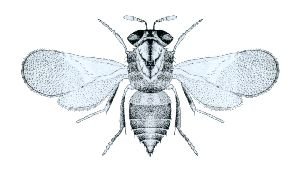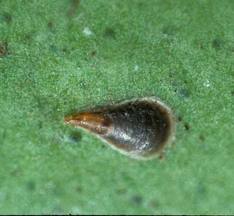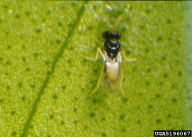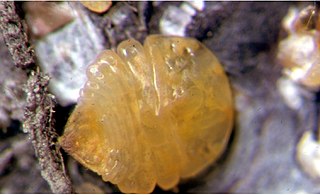
Parasitoid wasps are a large group of hymenopteran superfamilies, with all but the wood wasps (Orussoidea) being in the wasp-waisted Apocrita. As parasitoids, they lay their eggs on or in the bodies of other arthropods, sooner or later causing the death of these hosts. Different species specialise in hosts from different insect orders, most often Lepidoptera, though some select beetles, flies, or bugs; the spider wasps (Pompilidae) exclusively attack spiders.

The Aphelinidae are a moderate-sized family of tiny parasitic wasps, with about 1100 described species in some 28 genera. These minute insects are challenging to study, as they deteriorate rapidly after death unless extreme care is taken, making identification of most museum specimens difficult. The larvae of the majority are primary parasitoids on Hemiptera, though other hosts are attacked, and details of the life history can be variable. Males and females may have different hosts and different life histories.

Aonidiella aurantii or red scale is an armored scale insect and a major pest of citrus. It is thought to be a native of South China but has been widely dispersed by the agency of man through the movement of infected plant material. In the United States it is known as California red scale. It was first found in California between 1868 and 1875, apparently brought there on planting material imported from Australia.

Encarsia formosa is a species of chalcidoid wasp and a well known parasitoid of greenhouse whitefly, one of the first to be used commercially for biological pest control, from the 1920s. They can use at least 15 species of whitefly as a host, including Bemisia tabaci and Aleyrodes proletella.

A wasp is any insect of the narrow-waisted suborder Apocrita of the order Hymenoptera which is neither a bee nor an ant; this excludes the broad-waisted sawflies (Symphyta), which look somewhat like wasps, but are in a separate suborder. The wasps do not constitute a clade, a complete natural group with a single ancestor, as bees and ants are deeply nested within the wasps, having evolved from wasp ancestors. Wasps that are members of the clade Aculeata can sting their prey.
Aphytis melinus is an internal parasite of the California red scale, Aonidiella aurantii, which is a pest of citrus in California and elsewhere. This wasp drums its antennae against the scale insect to find out if it is healthy, if it is already parasitized, how large it is, etc., to decide how to use this prey. It has four choices : leave the scale to keep searching, feed directly on the scale, use the scale as a host for a male A. melinus, or use the scale for a female A. melinus.

Aleurocanthus woglumi is a species of whitefly in the family Aleyrodidae. It is a pest of citrus crops, and is commonly known as the citrus blackfly because of its slate-blue colour. It originated in Asia, but has spread to other parts of the world. The parasitic wasps, Encarsia perplexa and Amitus hesperidum can help control the pest.

Encarsia perplexa is a tiny parasitic wasp, a parasitoid of the citrus blackfly, Aleurocanthus woglumi, which is a global pest of citrus trees. It was originally misidentified as Encarsia opulenta, but was recorded as a new species in 1998. It is a native of Asia but has been introduced to many other parts of the world as a means of controlling the citrus blackfly.

Amitus hesperidum is a tiny parasitic wasp. It is a parasitoid of the citrus blackfly, Aleurocanthus woglumi, an important pest of citrus trees. It is a native of Asia but has been introduced to many other parts of the world as a means of controlling the citrus blackfly.

Encarsia is a large genus of minute parasitic wasps of the family Aphelinidae. The genus is very diverse with currently about 400 described species and worldwide distribution. The number of existing species is expected to be several times higher because many species are still undescribed. Encarsia is a very complex genus, with specimens showing both inter- and intra-specific variations, making morphological classification difficult.
Aphytis mytilaspidis is a species of chalcid wasp in the Aphelinidae family. The adults feed on scale insects and the larvae are ectoparasites of scales.

Lepidosaphes beckii also known as purple scale, mussel scale, citrus mussel scale, orange scale, comma scale and mussel purple scale is a scale insect that is a pest of Citrus trees. The small insects attach themselves to leaves, fruits and small branches and cause injury by sucking the tree's sap.
Encarsia inaron is a parasitoid wasp used in the control of ash whitefly, Siphoninus phillyreae. The ash whitefly is an insect from Europe that feeds on the sap of plants, and which has become a pest in North America. E. inaron was acquired from Italy and Israel and brought to California in 1989.

Planococcus citri, commonly known as the citrus mealybug, is a species of mealybugs native to Asia. It has been introduced to the rest of the world, including Europe, the Americas, and Oceania, as an agricultural pest. It is associated with citrus, but it attacks a wide range of crop plants, ornamental plants, and wild flora.

Copidosoma is a genus of chalcid wasps, which are parasitoids of Lepidoptera. The wasps are polyembryonic, depositing one or two eggs into their host which then develop into multiple offspring and have a soldier caste and a reproductive caste.

Tamarixia radiata, the Asian citrus cyllid parasitoid, is an hymenopteran wasp from the family Eulophidae which was discovered in the 1920s in the area of northwestern India (Punjab), now Pakistan. It is a parasitoid of the Asian citrus psyllid, an economically important pest of citrus crops around the world and a vector for Citrus greening disease.
Aphidius nigripes is a species of parasitoid wasp in the subfamily Aphidiinae of the family Braconidae. It is the most common parasitoid of the potato aphid Macrosiphum euphorbiae in eastern North America. Many other species of aphids may also serve as hosts.

Comperiella bifasciata is a parasitic wasp species in the genus Comperiella in the family Encyrtidae. It is used in biological control of California red scale and yellow scale of citrus.
Aonidiella citrina or yellow scale is an armored scale insect from the family Diaspididae. It feeds by sucking sap from plants in a number of plant families, but is mostly known for being a pest of citrus.

Quadraspidiotus juglansregiae, commonly known as the walnut scale, is a species of armoured scale insect in the family Diaspididae. It is native to North America where it feeds on a wide range of ornamental and forest trees and bushes.













